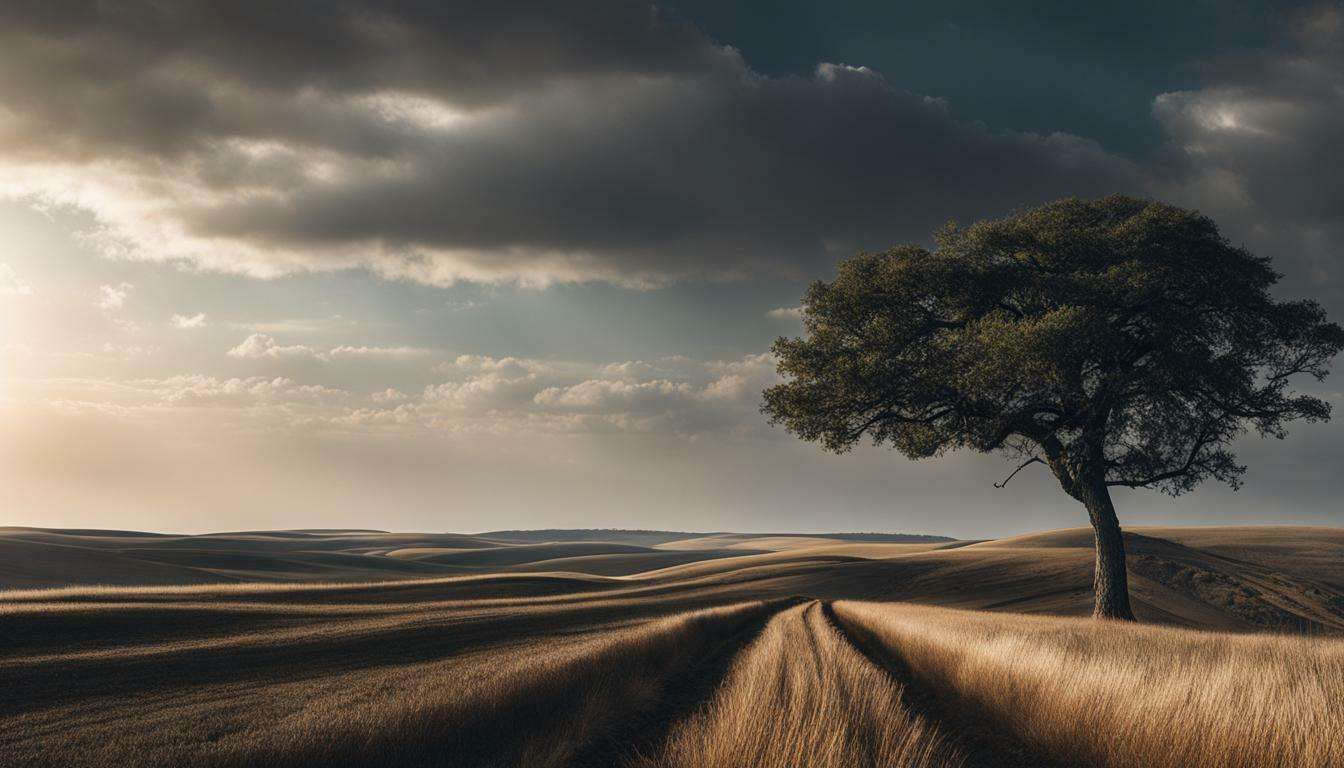The rule of thirds is a composition technique that plays a crucial role in creating visually captivating images. By dividing an image into nine equal parts using two horizontal and two vertical lines, this technique helps photographers and visual artists create balanced compositions that are pleasing to the eye. Placing the main subject of the photo on one of the four intersections or along the lines adds a sense of visual appeal and draws the viewer’s attention.
In South Africa’s vibrant media landscape, where visual content is paramount, understanding and applying composition techniques like the rule of thirds can greatly enhance the impact of photographs and videos. Whether capturing the stunning landscapes, vibrant portraits, captivating wildlife, or the bustling streets of South Africa, the rule of thirds helps create a visual hierarchy and guides the viewer’s eye through the image, providing a more immersive and engaging experience.
Key Takeaways:
- The rule of thirds divides an image into nine equal parts using two horizontal and two vertical lines.
- Placing the main subject at the intersections or along the lines creates a visually pleasing composition.
- The rule of thirds can be applied in various genres, including landscape, portrait, wildlife, and street photography.
- While the rule of thirds is a useful guideline, it is not a strict rule and can be broken for artistic purposes.
- Other composition techniques, such as symmetry and the golden ratio, can also be explored for creating visually interesting compositions.
Understanding the Rule of Thirds
Understanding the rule of thirds is essential for any photographer or visual artist seeking to enhance their composition skills. This widely known composition guideline divides an image into nine equal parts using two horizontal and two vertical lines, creating a grid. By placing the main subject of the photo on one of the four intersections or along the lines, a balanced and visually appealing composition is achieved. The rule of thirds helps to create a sense of balance and guides the viewer’s eye through the image, resulting in a more engaging photographic experience.
Visual hierarchy plays a crucial role in applying the rule of thirds effectively. By positioning the main subject off-center, the eye is naturally drawn to the focal point, and the composition feels more dynamic. Leading lines are another important aspect of the rule of thirds. These lines, whether actual elements in the scene or implied through shape or perspective, direct the viewer’s gaze and enhance the overall composition.
While the rule of thirds is an invaluable technique, it is not a rigid rule that must be followed at all times. The goal is to achieve visually captivating compositions, and breaking the rule for artistic purposes can yield unique and striking results. Exploring other composition techniques, such as symmetry and the golden ratio, can further enhance one’s ability to create compelling visuals.
| Key Points |
|---|
| The rule of thirds divides an image into nine equal parts using horizontal and vertical lines. |
| Placing the main subject on the intersections or along the lines creates balanced compositions. |
| Visual hierarchy and leading lines guide the viewer’s eye and enhance the composition. |
| While the rule of thirds is useful, it can be broken for artistic purposes. |
To assist photographers in applying the rule of thirds, many cameras and editing programs provide grid overlays. These overlays serve as a helpful tool for aligning key elements in the composition, but strict adherence to the rule is not necessary for creating impactful visuals. Experimenting with other compositional techniques, such as framing, negative space, balance, and color theory, can expand an artist’s creative horizons and result in visually stunning compositions.
Applying the Rule of Thirds in Various Genres
The rule of thirds is a versatile composition technique that can be applied in various genres of photography to create captivating and balanced compositions. Whether you’re capturing the grandeur of a landscape, the depth of a portrait, the beauty of wildlife, or the energy of street scenes, the rule of thirds can guide you in creating visually stunning images.
In landscape photography, the rule of thirds helps to add depth and interest to your composition. By placing elements such as the horizon, mountains, or trees along the horizontal lines, you can create a balanced image that draws the viewer’s eye into the scene. For example, in a sunset shot, positioning the sun at one of the intersections can create a dynamic composition that captures the viewer’s attention.
When it comes to portrait photography, the rule of thirds can help you achieve pleasing and harmonious compositions. Placing the subject’s eyes or face along the intersecting lines can create a natural balance and draw attention to the most important features. This technique adds visual interest and captures the viewer’s attention while maintaining a strong connection with the subject.
Wildlife photography also benefits from the rule of thirds. By positioning the animal or bird along one of the lines or intersections, you can create a sense of movement or action within the frame. This technique adds dynamism and visual appeal to your wildlife photographs, as well as ensuring that the subject remains the focal point of the image.
Street photography offers a unique opportunity to capture the energy and essence of everyday life. By applying the rule of thirds, you can create visually balanced compositions that tell a story. Whether it’s capturing a bustling street scene or a solitary figure against a vibrant backdrop, consider how the rule of thirds can enhance the overall aesthetic and impact of your street photographs.
| Genre | Rule of Thirds Application |
|---|---|
| Landscape Photography | Placing horizon, mountains, or trees along the horizontal lines to add depth and visual interest. |
| Portrait Photography | Positioning subject’s eyes or face along the intersecting lines to create a natural balance and draw attention to important features. |
| Wildlife Photography | Positioning the animal or bird along the lines or intersections to add movement and maintain focus on the subject. |
| Street Photography | Creating visually balanced compositions that capture the energy and essence of everyday life. |
Beyond the Rule of Thirds: Exploring Other Techniques
While the rule of thirds is a powerful composition technique, exploring other techniques can further enhance one’s ability to create compelling compositions. In addition to symmetry and the golden ratio, other concepts such as framing, negative space, balance, and color theory can bring unique visual appeal to your photographs.
One effective technique is framing, where you use elements within the scene to create a frame around your subject. This can add depth and focus to your composition, drawing the viewer’s attention to the main subject. For example, you can use overhanging branches or architectural structures to create a natural frame around your subject, adding layers of interest to your photo.
Negative space is another technique that can create a powerful impact. By deliberately leaving empty space around your subject, you can evoke a sense of minimalism and simplicity. This technique can highlight the main subject and create a sense of balance within the composition. It allows the viewer’s eyes to rest and appreciate the subject without distractions.
Color theory is another aspect to consider when exploring composition techniques. Understanding how colors complement or contrast with each other can greatly enhance the visual impact of your photographs. The careful use of color can create a mood or evoke certain emotions in the viewer. Experiment with color combinations and pay attention to how different hues interact within your composition.
| Composition Techniques | Examples |
|---|---|
| Symmetry | A perfectly symmetrical reflection in a still lake |
| Framing | Overhanging branches creating a natural frame around a portrait |
| Negative Space | A minimalist landscape with a vast expanse of sky |
| Balance | A silhouette of a person standing on a mountain peak against a colorful sunset |
| Color Theory | A vibrant still life arrangement with complementary colors |
Exploring these various composition techniques allows you to push the boundaries of your creativity and capture unique and visually captivating images. Don’t be afraid to experiment and break the rules to create compositions that truly stand out.
Utilizing Tools for Composition: Grid Overlays
Many cameras and editing programs offer grid overlays that can aid photographers in applying the rule of thirds and other composition techniques. These grid overlays consist of two horizontal and two vertical lines, dividing the image into nine equal parts. By aligning the main subject or points of interest along these lines or intersections, photographers can create a balanced and visually pleasing composition.
The grid overlay serves as a visual guide, helping photographers maintain proper visual hierarchy and leading lines within their images. It allows them to place elements strategically, ensuring a sense of balance and guiding the viewer’s eye through the photograph. This enhances the overall viewing experience and creates more engaging compositions.
While the rule of thirds is a helpful guideline, it is not a strict rule that must be followed at all times. The grid overlay can be used as a starting point for composition, but photographers should also feel free to experiment with other techniques and push creative boundaries. Symmetry, negative space, and color theory are examples of other composition methods that can be explored to create unique and visually impactful images.
Experimentation and Creative Freedom
Photographers should view the rule of thirds and grid overlays as tools to assist in composition, rather than strict templates. By experimenting with different composition techniques, photographers can develop their own style and artistic vision. The golden ratio, for example, is another compositional guideline that can create visually pleasing compositions.
| Tool | Benefits |
|---|---|
| Grid Overlay | Aids in applying the rule of thirds and maintaining visual balance |
| Symmetry | Creates a sense of harmony and balance in the composition |
| Negative Space | Emphasizes the main subject by surrounding it with empty space |
| Color Theory | Utilizes color harmony and contrast to create visually striking images |
Photographers are encouraged to utilize these composition techniques and explore their potential for visual appeal. Remember that while grid overlays can be helpful, they are just one tool in a photographer’s arsenal. Creativity and experimentation are key to developing unique and captivating compositions.
Experimenting with Composition Techniques
Exploring composition techniques beyond the rule of thirds allows for artistic experimentation and can greatly enhance the visual appeal of photographs and visual content. While the rule of thirds provides a solid foundation for creating balanced compositions, there are other techniques that photographers and visual artists can employ to add depth and interest to their work.
One such technique is the use of symmetry, which can create a sense of harmony and balance in an image. By capturing subjects or scenes that exhibit symmetrical elements, photographers can draw their viewers’ attention and create a powerful visual impact. Symmetry can be found in architecture, nature, and even in everyday objects, providing endless opportunities for experimentation.
Another technique worth exploring is the golden ratio, a mathematical concept that has been used in art and design for centuries. The golden ratio is a visually pleasing proportion that can be found in nature and is often associated with aesthetic beauty. By incorporating the golden ratio into compositions, photographers can create a natural flow and a sense of visual harmony that captivates the viewer’s attention.
| Composition Technique | Description |
|---|---|
| Symmetry | Creates a sense of balance and harmony by capturing symmetrical elements in an image. |
| Golden Ratio | Uses the mathematical concept of the golden ratio to create a visually pleasing proportion in compositions. |
It’s important to remember that experimenting with composition techniques is not about rigidly following rules, but rather about pushing creative boundaries and finding unique ways to express oneself. By combining different techniques, photographers and visual artists can create stunning and thought-provoking compositions that evoke emotions and tell compelling stories.
Cameras and editing programs often provide grid overlays to assist with applying the rule of thirds, but it’s worth noting that these overlays are just tools and shouldn’t limit one’s artistic vision. While the rule of thirds can be a helpful guideline, breaking it intentionally can lead to unexpected and exciting results. The key is to use composition techniques as tools to guide the viewer’s eye and create visually captivating content.
Conclusion
Composition techniques, including the rule of thirds, play a vital role in enhancing visual content and capturing the attention of audiences in South Africa’s dynamic media landscape. The rule of thirds, a widely known composition guideline, divides an image into nine equal parts using two horizontal and two vertical lines. By placing the main subject of the photo on one of the four intersections or along the lines, photographers can create balanced and visually appealing compositions.
South Africa’s diverse genres of photography, such as landscape, portrait, wildlife, and street photography, can all benefit from the application of the rule of thirds. This technique not only helps create a sense of balance within the frame but also guides the viewer’s eye, providing a more engaging photographic experience. However, it is important to note that the rule of thirds is not a strict rule and can be broken for artistic purposes.
Photographers and visual artists can further enhance their compositions by exploring other composition techniques, such as symmetry and the golden ratio. These techniques can add visual interest and create aesthetically pleasing images. While cameras and editing programs often provide grid overlays to assist with applying the rule of thirds, strict adherence to this guideline is not necessary. Experimenting with different compositional techniques will help photographers develop their unique visual style and create captivating content that resonates with audiences in South Africa’s vibrant media landscape.
How Does the Rule of Thirds Enhance Corporate Videography?
The rule of thirds plays a crucial role in enhancing corporate videography by helping to create balanced and visually appealing shots. By dividing the frame into a grid using horizontal and vertical lines, this rule guides videographers to position key elements at the intersecting points. This technique improves composition, grabbing viewers’ attention and conveying professionalism. Understanding the importance of corporate videography in business communication further emphasizes the significance of utilizing the rule of thirds.
How Does the Rule of Thirds Benefit a Videographer’s Composition?
The rule of thirds is a fundamental principle in videography that benefits a videographer’s composition by enhancing visual aesthetics. By dividing the frame into nine equal parts using imaginary lines, this rule helps videographers create a balanced and visually appealing shot. It allows for strategic placement of important elements, guiding viewers’ attention and adding depth to the scene. When consciously applied, the rule of thirds complements the videographer’s personality traits as it showcases their attention to detail and creative eye.
FAQ
What is the rule of thirds?
The rule of thirds is a composition guideline that divides an image into nine equal parts using two horizontal and two vertical lines. Placing the main subject on one of the four intersections or along the lines creates a balanced and visually appealing composition.
In which genres can the rule of thirds be applied?
The rule of thirds can be applied in various genres, including landscape, portrait, wildlife, and street photography. It helps create a sense of balance and guides the viewer’s eye through the image, providing a more engaging photographic experience.
Is the rule of thirds a strict rule?
While the rule of thirds is a useful technique, it is not a strict rule and can be broken for artistic purposes. Other composition techniques, such as symmetry and the golden ratio, can also be explored to create visually interesting compositions.
Do cameras and editing programs provide grid overlays for the rule of thirds?
Yes, cameras and editing programs often provide grid overlays to assist with applying the rule of thirds. However, it is not necessary to adhere strictly to the rule of thirds, as experimenting with other composition techniques can also enhance one’s ability to create compelling compositions.
What is the golden ratio?
The golden ratio is a mathematical concept that is often used in art and design to create aesthetically pleasing compositions. It is a ratio of approximately 1:1.618 and is believed to create a visually appealing sense of balance and harmony.
What is the importance of experimenting with composition techniques?
Experimenting with different composition techniques allows photographers and visual artists to push creative boundaries and create visually captivating content. It helps in finding a balance between adhering to guidelines and exploring new and unique approaches to composition.






